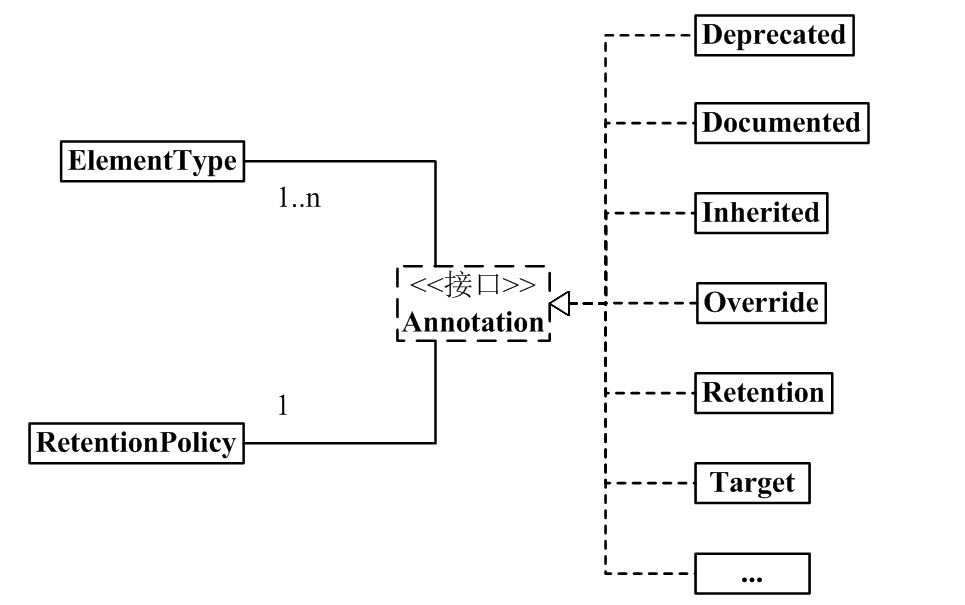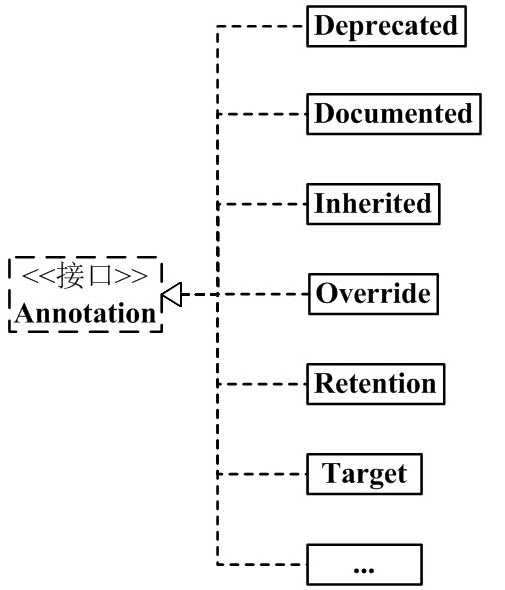Java Annotation使用详解
Posted value-code
tags:
篇首语:本文由小常识网(cha138.com)小编为大家整理,主要介绍了Java Annotation使用详解相关的知识,希望对你有一定的参考价值。
Java Annotation是JDK5.0引入的一种注释机制。它与注释有一定区别,可以理解为代码上的特殊标记,通过这些标记我们可以在编译,类加载,运行等程序类的生命周期内被读取、执行相应的处理。通过注解开发人员可以在不改变原有代码和逻辑的情况下在源代码中嵌入补充信息。
一、Annotation架构图

我们可以这样理解这张图:
(1)Annotation是个接口,它有RetentionPolicy和ElementType属性
(2)一个Annotation接口和一个RetentionPolicy相关联,和1~n个ElementType相关联
(3)右半边的Override、Target等都是java中自带的Annotation的实现类
二、RetentionPolicy和ElementType
RetentionPolicy和ElementType是Annotation重要的组成部分。
1、RetentionPolicy是Enum枚举类型,它用来指定Annotation的策略。通俗点说,就是不同RetentionPolicy类型的Annotation的作用域不同。
“每1个Annotation” 都与 “1个RetentionPolicy”关联。
a) 若Annotation的类型为 SOURCE,则意味着:Annotation仅存在于编译器处理期间,编译器处理完之后,该Annotation就没用了。
例如,“ @Override ”标志就是一个Annotation。当它修饰一个方法的时候,就意味着该方法覆盖父类的方法;并且在编译期间会进行语法检查!编译器处理完后,“@Override”就没有任何作用了。
b) 若Annotation的类型为 CLASS,则意味着:编译器将Annotation存储于类对应的.class文件中,它是Annotation的默认行为。
c) 若Annotation的类型为 RUNTIME,则意味着:编译器将Annotation存储于class文件中,并且可由JVM读入。
2、 ElementType 是Enum枚举类型,它用来指定Annotation的类型。
“每1个Annotation” 都与 “1~n个ElementType”关联。当Annotation与某个ElementType关联时,就意味着:Annotation有了某种用途。
例如,若一个Annotation对象是METHOD类型,则该Annotation只能用来修饰方法。
三、定义Annotation
Annotation的通用定义:
@Documented
@Target(ElementType.TYPE)
@Retention(RetentionPolicy.RUNTIME)
public @interface MyFirstAnnotation {
}
这段代码定义了一个Annotation,它的名字是MyFirstAnnotation。定义之后,我们就可以在代码中使用“@MyFirstAnnotation”来调用它。
而其它的@Documented, @Target, @Retention, @interface都是来修饰MyFirstAnnotation的。它们的含义如下:
(1) @interface
使用@interface定义注解时,意味着它实现了java.lang.annotation.Annotation接口,即该注解就是一个Annotation。
定义Annotation时,@interface是必须的。
注意:它和我们通常的implemented实现接口的方法不同。Annotation接口的实现细节都由编译器完成。通过@interface定义注解后,该注解不能继承其他的注解或接口。
(2)@Documented
类和方法的Annotation在缺省情况下是不出现在javadoc中的。如果使用@Documented修饰该Annotation,则表示它可以出现在javadoc中。
定义Annotation时,@Documented可有可无;若没有定义,则Annotation不会出现在javadoc中。
(3)@Target(ElementType.TYPE)
前面我们说过,ElementType 是Annotation的类型属性。而@Target的作用,就是来指定Annotation的类型属性。
@Target(ElementType.TYPE) 的意思就是指定该Annotation的类型是ElementType.TYPE。这就意味着,MyAnnotation1是来修饰“类、接口(包括注释类型)或枚举声明”的注解。
定义Annotation时,@Target可有可无。若有@Target,则该Annotation只能用于它所指定的地方;若没有@Target,则该Annotation可以用于任何地方。.
(4)@Retention(RetentionPolicy.RUNTIME)
前面我们说过,RetentionPolicy 是Annotation的策略属性,而@Retention的作用,就是指定Annotation的策略属性。
@Retention(RetentionPolicy.RUNTIME) 的意思就是指定该Annotation的策略是RetentionPolicy.RUNTIME。这就意味着,编译器会将该Annotation信息保留在.class文件中,并且能被虚拟机读取。
定义Annotation时,@Retention可有可无。若没有@Retention,则默认是RetentionPolicy.CLASS。
四、Java自带的Annotation
也就是Annotation架构图中的右半边:

由于“@Deprecated和@Override”类似,“@Documented, @Retention, @Target”在上文已经做过解释;下面,我们对@Deprecated, @Inherited, @SuppressWarnings 这3个Annotation进行说明。
1、@Deprecated,定义如下:
@Documented
@Retention(RetentionPolicy.RUNTIME)
public @interface Deprecated {
}
说明:
(1) @interface -- 它的用来修饰Deprecated,意味着Deprecated实现了java.lang.annotation.Annotation接口;即Deprecated就是一个注解。
(2) @Documented -- 它的作用是说明该注解能出现在javadoc中。
(3) @Retention(RetentionPolicy.RUNTIME) -- 它的作用是指定Deprecated的策略是RetentionPolicy.RUNTIME。这就意味着,编译器会将Deprecated的信息保留在.class文件中,并且能被虚拟机读取。
(4) @Deprecated 所标注内容,不再被建议使用。
例如,若某个方法被 @Deprecated 标注,则该方法不再被建议使用。如果有开发人员试图使用或重写被@Deprecated标示的方法,编译器会给相应的提示信息。
2、@Inherited,定义如下:
@Documented
@Retention(RetentionPolicy.RUNTIME)
@Target(ElementType.ANNOTATION_TYPE)
public @interface Inherited {
}
说明:
(1) @interface -- 它的用来修饰Inherited,意味着Inherited实现了java.lang.annotation.Annotation接口;即Inherited就是一个注解。
(2) @Documented -- 它的作用是说明该注解能出现在javadoc中。
(3) @Retention(RetentionPolicy.RUNTIME) -- 它的作用是指定Inherited的策略是RetentionPolicy.RUNTIME。这就意味着,编译器会将Inherited的信息保留在.class文件中,并且能被虚拟机读取。
(4) @Target(ElementType.ANNOTATION_TYPE) -- 它的作用是指定Inherited的类型是ANNOTATION_TYPE。这就意味着,@Inherited只能被用来标注“Annotation类型”。
(5) @Inherited 的含义是,它所标注的Annotation将具有继承性。
假设,我们定义了某个Annotaion,它的名称是MyAnnotation,并且MyAnnotation被标注为@Inherited。现在,某个类Base使用了MyAnnotation,则Base具有了“具有了注解MyAnnotation”;现在,Sub继承了Base,由于MyAnnotation是@Inherited的(具有继承性),所以,Sub也“具有了注解MyAnnotation”。
3、@SuppressWarnings,定义如下:
@Target({TYPE, FIELD, METHOD, PARAMETER, CONSTRUCTOR, LOCAL_VARIABLE})
@Retention(RetentionPolicy.SOURCE)
public @interface SuppressWarnings {
String[] value();
}
说明:
(01) @interface -- 它的用来修饰SuppressWarnings,意味着SuppressWarnings实现了java.lang.annotation.Annotation接口;即SuppressWarnings就是一个注解。
(02) @Retention(RetentionPolicy.SOURCE) -- 它的作用是指定SuppressWarnings的策略是RetentionPolicy.SOURCE。这就意味着,SuppressWarnings信息仅存在于编译器处理期间,编译器处理完之后SuppressWarnings就没有作用了。
(03) @Target({TYPE, FIELD, METHOD, PARAMETER, CONSTRUCTOR, LOCAL_VARIABLE}) -- 它的作用是指定SuppressWarnings的类型同时包括TYPE, FIELD, METHOD, PARAMETER, CONSTRUCTOR, LOCAL_VARIABLE。
TYPE意味着,它能标注“类、接口(包括注释类型)或枚举声明”。
FIELD意味着,它能标注“字段声明”。
METHOD意味着,它能标注“方法”。
PARAMETER意味着,它能标注“参数”。
CONSTRUCTOR意味着,它能标注“构造方法”。
LOCAL_VARIABLE意味着,它能标注“局部变量”。
(04) String[] value(); 意味着,SuppressWarnings能指定参数
(05) SuppressWarnings 的作用是,让编译器对“它所标注的内容”的某些警告保持静默。例如,"@SuppressWarnings(value={"deprecation", "unchecked"})" 表示对“它所标注的内容”中的 “SuppressWarnings不再建议使用警告”和“未检查的转换时的警告”保持沉默。
以上是关于Java Annotation使用详解的主要内容,如果未能解决你的问题,请参考以下文章